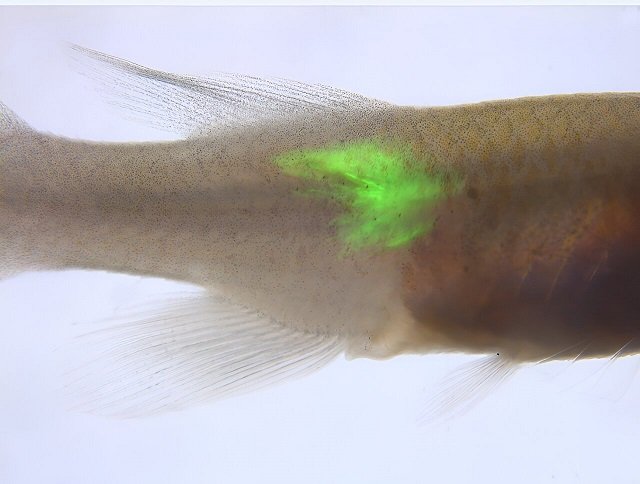
Pituitary hormones play a fundamental role in orchestrating key events in the life history of vertebrates. These events include growth, reproduction, metabolism, and aging, all of which are vital for an organism’s survival and adaptation to its environment.
Achieving precise control over hormonal levels on different time scales is essential to fine-tune these traits. However, this has been a formidable challenge in the field of experimental biology.
A team of researchers from The Hebrew University of Jerusalem and the University of South Bohemia in Ceske Budejovice studied the short-lived turquoise killifish (Nothobranchius furzeri) to develop a high-throughput platform that combines the loss and gain of function of peptide hormones.
They have introduced an innovative platform for controlling peptide hormones in fish, providing a fast and effective way to broadly study fish biology.
Peptide Hormones
Peptide hormones from the pituitary gland play a vital role in regulating key events in the life of vertebrates, such as growth, reproduction, metabolism, and aging.
Accurately controlling hormone levels over various time periods is crucial for managing these traits properly. However, conducting experiments to regulate hormones within living organisms has historically been a challenging task.
Information on Loss of Function
In a significant breakthrough, the research team introduced a novel approach using the small turquoise killifish as a model organism. Their research reveals a versatile platform capable of performing two types of manipulations: loss-of-function and gain-of-function studies, specifically targeting peptide hormones in fish.
The researchers focused on three major pituitary hormones: growth hormone (gh1), follicle-stimulating hormone (fshb), and thyroid-stimulating hormone (tshb).
By mutating these hormones in turquoise killifish, scientists obtained valuable information about the role of these hormones in somatic growth and reproduction.
This innovative discovery indicates that, despite their rapid growth and maturation, turquoise killifish rely on evolutionarily conserved genetic networks, reaffirming the importance of pituitary hormones in the life history of vertebrates.
The Innovative Gain-of-Function System
In the next phase of their research, scientists devised a system for precisely controlling hormonal expression. This system attaches a specialized fluorescent marker to hormones and then introduces these marked hormones into the fish’s body using a technique called intramuscular electroporation.
The researchers developed a gain-of-function system that allows for precise manipulation of hormonal expression.
Surprisingly, a single electroporation treatment allowed hormone-deficient fish to maintain essential traits, including reproductive capacities, for extended periods. The researchers demonstrated the adaptability of their method by combining multiple hormonal interventions, accurately controlling their levels, and regulating hormonal activation as needed.
In this system, a hormone is tagged with a self-cleaving fluorescent indicator and introduced into the fish via intramuscular electroporation.
Versatility and Precision
One of the most remarkable aspects of this approach is its versatility. Researchers were able to use multiplexing systems, dose-dependent methods, and doxycycline-inducible techniques to achieve tunable and reversible hormonal expression.
This level of precision offers a powerful tool for studying the complex dynamics of pituitary hormones and their impact on the life history of vertebrates.
Implications and Future Applications
The implications of this research extend beyond our understanding of turquoise killifish. This high-throughput method not only provides a wealth of insights into pituitary hormones but also holds promise for broader applications.
In summary, this innovative method offers a fast and effective means to study fish biology on a large scale. Its potential applications go beyond research and encompass possibilities for revolutionizing aquaculture practices, clinical hormone management, and research into methods for extending the lifespan of vertebrates.
Conclusion
The innovative combination of loss and gain-of-function experiments, along with versatile and precise hormonal manipulation techniques, has revealed a hidden treasure of knowledge.
Professor Itamar Harel of The Hebrew University of Jerusalem said, “Our platform opens new horizons for understanding the role of peptide hormones in vertebrate biology and provides a powerful tool for researchers in this field. It also holds promise for applications in aquaculture and the exploration of interventions to improve longevity.”
This research not only enhances our knowledge of turquoise killifish but also has the potential to revolutionize the fields of aquaculture and aging studies.
Contact
Itamar Harel
Department of Genetics
the Silberman Institute
The Hebrew University of Jerusalem, Jerusalem, Israel
Email: itamarh@mail.huji.ac.il
Reference (open access)
Eitan Moses, Roman Franek, Itamar Harel (2023) A scalable and tunable platform for functional interrogation of peptide hormones in fish eLife 12:e85960. https://doi.org/10.7554/eLife.85960
Editor at the digital magazine AquaHoy. He holds a degree in Aquaculture Biology from the National University of Santa (UNS) and a Master’s degree in Science and Innovation Management from the Polytechnic University of Valencia, with postgraduate diplomas in Business Innovation and Innovation Management. He possesses extensive experience in the aquaculture and fisheries sector, having led the Fisheries Innovation Unit of the National Program for Innovation in Fisheries and Aquaculture (PNIPA). He has served as a senior consultant in technology watch, an innovation project formulator and advisor, and a lecturer at UNS. He is a member of the Peruvian College of Biologists and was recognized by the World Aquaculture Society (WAS) in 2016 for his contribution to aquaculture.
